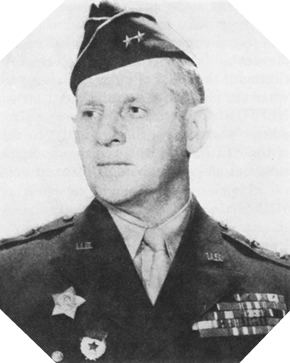Years of service 1910–50 | Name Clarence Huebner | |
 | ||
Born November 24, 1888Bushton, Kansas, USA ( 1888-11-24 ) Allegiance United States of America Commands held 1st Infantry DivisionV Corps Battles/wars World War IWorld War IINormandySaint-Lo Awards Distinguished Service Cross (2)Distinguished Service Medal (3)Legion of MeritSilver StarBronze StarPurple Heart (2) Died September 23, 1972, Washington, D.C., United States Similar People Leland Hobbs, Courtney Hodges, Gerhard Wilck, Arthur W Radford | ||
LTG Clarence Huebner, D Day Veteran at Arlington National Cemetery
Lieutenant General Clarence Ralph Huebner (November 24, 1888 – September 23, 1972) was a highly decorated senior officer of the United States Army who saw service during both World War I and World War II.
Contents
- LTG Clarence Huebner D Day Veteran at Arlington National Cemetery
- World War I
- The Big Red One
- V Corps command
- Postwar service
- In popular culture
- Decorations
- References

World War I
A farm boy from Bushton, Kansas, who spent almost seven years serving from private to sergeant in the 18th Infantry Regiment, Huebner received a regular commission in November 1916.
During World War I he served on the Western Front and was sent to France with his regiment, the 28th Infantry, which later became part of the 1st Infantry Division ("The Big Red One"), shortly after the American entry into World War I. The division was the first of the American Expeditionary Force (AEF) to be sent overseas during the war. The following year he participated in the first American regimental assault at Cantigny through Soissons, Saint-Mihiel, and the Meuse-Argonne. For his service in this war, he received two Distinguished Service Crosses, a Distinguished Service Medal, and a Silver Star. He commanded the 2nd Battalion, 28th Infantry at Cantigny after his commanding officer was killed, and later commanded the regiment, one of the youngest regimental commanders in the AEF.
Remaining in the army after the war, he attended the U.S. Army Command and General Staff School at Fort Leavenworth in 1924 and served on its faculty from 1929 to 1933.
The Big Red One
In 1943, General Huebner relieved the popular commander of the 1st Infantry Division, General Terry Allen, in a move engineered by General Omar N. Bradley. While the 1st ID, aka The Big Red One had enjoyed considerable combat success under Allen's leadership, Bradley was highly critical of both Allen and Roosevelt's wartime leadership style, which favored fighting ability over drill and discipline: "While the Allies were parading decorously through Tunis," Bradley wrote, "Allen's brawling 1st Infantry Division was celebrating the Tunisian victory in a manner all its own. In towns from Tunisia all the way to Arzew, the division had left a trail of looted wine shops and outraged mayors. But it was in Oran...that the division really ran amuck. The trouble began when SOS (Services of Supply) troops, long stationed in Oran, closed their clubs and installations to our combat troops from the front. Irritated by this exclusion, the 1st Division swarmed into town to 'liberate' it a second time." Despite this, Bradley admitted that "none excelled the unpredictable Terry Allen in the leadership of troops."
Upon assuming command, General Huebner immediately ordered a series of close-order drills, parades, and weapons instruction for the 1st ID, including its veterans, who had just finished a bloody series of engagements with German forces in Sicily. This did not endear him to the enlisted men of the division, who made no attempt to hide their preference for General Allen. As one of the men of the Big Red One said in disgust, "Hell's bells! We've been killing Germans for months and now they are teaching us to shoot a rifle? It doesn't make any sense."
Supported by Bradley and Eisenhower, Huebner persisted, and the morale of the division gradually recovered. As the commander of the "Big Red One" in World War II, Huebner led the 1st in the assault on Omaha Beach, followed by a successful infantry attack at Saint-Lô. The 1st would later repel a German counteroffensive at Mortain, and pursue the German Army across France, culminating in the Battles of Aachen and the Huertgen Forest.
V Corps command
In January 1945 Huebner took command of the V Corps, which he directed from the Rhine to the Elbe, where his troops made first contact with the Red Army.
Postwar service
After World War II, Huebner was the last Military Governor (acting) of the American Zone in Germany from May 15, 1949, to September 1, 1949. He retired in 1950. On September 1, 1951, he became director of New York State's Civil Defense Commission, a post he held until January 1961. A strong advocate of the building of fallout shelters, General Huebner believed the US population would eventually be forced to live full-time in underground shelters and "would see the sunshine only by taking a calculated risk".
Huebner married Florence Barrett in 1921. Following her death in 1966, Huebner married Anna Imelda Mathews in 1968. She died in 1974. All three are buried together in Arlington National Cemetery.
In popular culture
Huebner was portrayed by Charles Macaulay in the 1980 film The Big Red One, in the opening sequence set in World War I and, in the reconstructed extended version, in 1944 just prior to the Battle of Huertgen Forest.
Decorations
Lieutenant General Huebner received many military awards for bravery and distinguished service during both World Wars.
